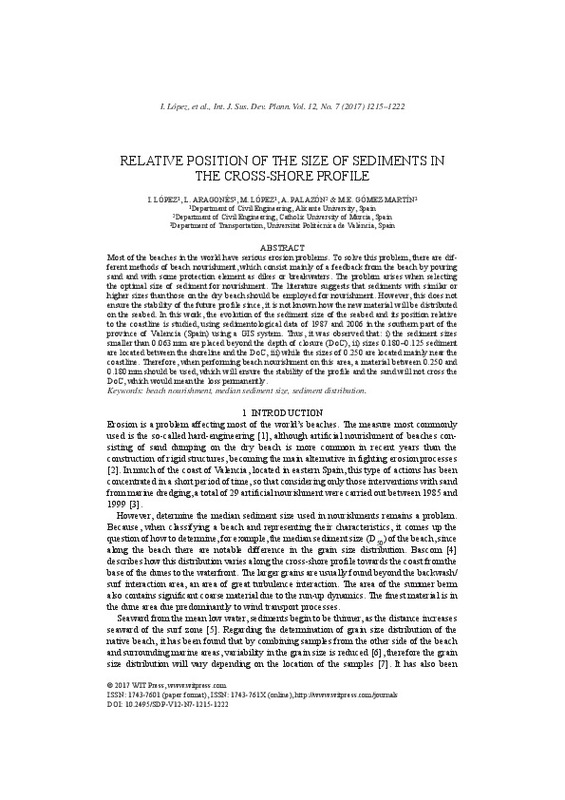JavaScript is disabled for your browser. Some features of this site may not work without it.
Buscar en RiuNet
Listar
Mi cuenta
Estadísticas
Ayuda RiuNet
Admin. UPV
Relative position of the size of sediments in the cross-shore profile
Mostrar el registro sencillo del ítem
Ficheros en el ítem
| dc.contributor.author | López, Isabel
|
es_ES |
| dc.contributor.author | Aragonés, Luís
|
es_ES |
| dc.contributor.author | López, Mercedes
|
es_ES |
| dc.contributor.author | Palazón, Antonio
|
es_ES |
| dc.contributor.author | Gómez Martín, María Esther
|
es_ES |
| dc.date.accessioned | 2017-10-20T07:14:33Z | |
| dc.date.available | 2017-10-20T07:14:33Z | |
| dc.date.issued | 2017 | es_ES |
| dc.identifier.issn | 1743-7601 | es_ES |
| dc.identifier.uri | http://hdl.handle.net/10251/89665 | |
| dc.description.abstract | [EN] Most of the beaches in the world have serious erosion problems. To solve this problem, there are different methods of beach nourishment, which consist mainly of a feedback from the beach by pouring sand and with some protection element as dikes or breakwaters. The problem arises when selecting the optimal size of sediment for nourishment. The literature suggests that sediments with similar or higher sizes than those on the dry beach should be employed for nourishment. However, this does not ensure the stability of the future profile since, it is not known how the new material will be distributed on the seabed. In this work, the evolution of the sediment size of the seabed and its position relative to the coastline is studied, using sedimentological data of 1987 and 2006 in the southern part of the province of Valencia (Spain) using a GIS system. Thus, it was observed that: i) the sediment sizes smaller than 0.063 mm are placed beyond the depth of closure (DoC), ii) sizes 0.180 0.125 sediment are located between the shoreline and the DoC, iii) while the sizes of 0.250 are located mainly near the coastline. Therefore, when performing beach nourishment on this area, a material between 0.250 and 0.180 mm should be used, which will ensure the stability of the profile and the sand will not cross the DoC, which would mean the loss permanently. | es_ES |
| dc.language | Inglés | es_ES |
| dc.relation.ispartof | International Journal of Sustainable Development and Planning | es_ES |
| dc.rights | Reserva de todos los derechos | |
| dc.subject | Beach nourishment | es_ES |
| dc.subject | Median sediment size | es_ES |
| dc.subject | Sediment distribution | es_ES |
| dc.subject.classification | INGENIERIA E INFRAESTRUCTURA DE LOS TRANSPORTES | es_ES |
| dc.title | Relative position of the size of sediments in the cross-shore profile | es_ES |
| dc.type | Artículo | es_ES |
| dc.identifier.doi | 10.2495/SDP-V12-N7-1215-1222 | es_ES |
| dc.rights.accessRights | Abierto | es_ES |
| dc.contributor.affiliation | Universitat Politècnica de València. Departamento de Ingeniería e Infraestructura de los Transportes - Departament d'Enginyeria i Infraestructura dels Transports | es_ES |
| dc.description.bibliographicCitation | López, I.; Aragonés, L.; López, M.; Palazón, A.; Gómez Martín, ME. (2017). Relative position of the size of sediments in the cross-shore profile. International Journal of Sustainable Development and Planning. 12(7):1215-1222. doi:10.2495/SDP-V12-N7-1215-1222 | es_ES |
| dc.description.accrualMethod | S | es_ES |
| dc.relation.publisherversion | http://dx.doi.org/10.2495/SDP-V12-N7-1215-1222 | es_ES |
| dc.description.upvformatpinicio | 1215 | es_ES |
| dc.description.upvformatpfin | 1222 | es_ES |
| dc.type.version | info:eu-repo/semantics/publishedVersion | es_ES |
| dc.description.volume | 12 | es_ES |
| dc.description.issue | 7 | es_ES |
| dc.relation.pasarela | S\330736 | es_ES |








